The top 10 sights in Istanbul
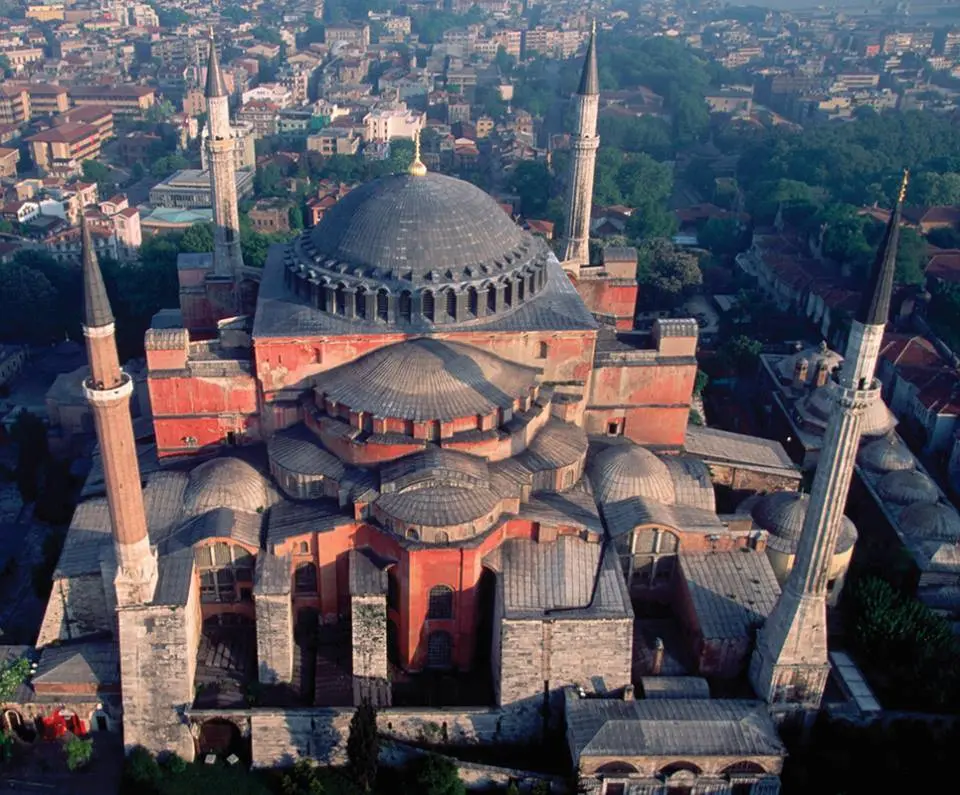
The top 10 sights in Istanbul
The top 10 sights in Istanbul
Istanbul has many historical places. Palaces, mosques, towers, bazaars and more. We found the top 10 sights in Istanbul of these for you. You can find this information in our article below. We hope this information will help you on your Istanbul vacation.
Topkapı Palace
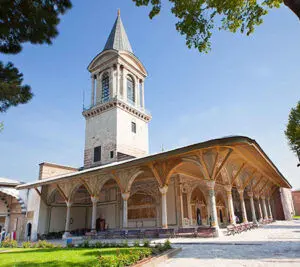
Topkapi Palace
Topkapı Palace is one of the biggest and most popular palace to visit in Istanbul. It is include in the Unesco World Heritage List in 1985. Topkapı Palace on the place known as the historical peninsula in Istanbul old city.
Topkapı Palace has hosted 22 different Sultans and their families and the political center of the Ottoman empire for 400 years. Each sultan added a different section or hall to his palace according to his own need. Topkapı Palace architecture is typical Turkish style palace.
Topkapı Palace was opened to the public as a museum upon the order of Atatürk in 1924. Today, there are many sections that can be visit in Topkapı Palace. In some exhibition halls there are the Treasury, the costumes of the Sultans and the Sacred relics.
Hagia Sophia
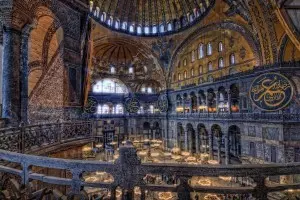
Hagia Sophia
Hagia Sophia means “Holly Wisdom”. This is an Orthodox church cathedral dedicated to holly wisdom. It is a former Byzantine church and former Ottoman mosque. It located in Sultanahmet
neighborhood being one of the most important museums of Istanbul considered as a World Heritage by Unesco. It is one of the greatest surviving examples of Byzantine architecture.
The first church of Hagia Sophia was built on the same site in the 4th century by Constantine the Great and renovated by his son Constantinus II in 360 AD.
Hagia Sophia, one of the historical architectural wonders that still remains standing today, has an important place in the art world with its architecture, grandness, size and functionality.
Following the capture of Constantinople by the Ottoman Turks in On May 29th, 1453, the Ottomans conquered Constantinople and Sultan Mehmet II ordered to convert the church into a mosque. As a mosque, it was considered as one of the holiest Islamic temples of the world.
Under the order of Mustafa Kemal Ataturk and the Council of Ministers the Hagia Sophia opened as a museum in 1935.
Basilica Cistern
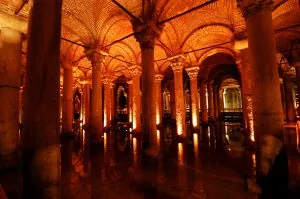
Basilica Cistern
One of the historical buildings of Istanbul is the Basilica Cistern. Built by the Byzantine Emperor Justinianus (527-565), this large underground cistern was named as the “Basilica Palace” among the people because of the marble columns rising from the water. Since there is a Basilica in the place where the cistern was, it is also known as the Basilica Cistern.
The cistern is a giant building covering a rectangular area of 140 meters in length and 70 meters in width. Covering a total area of 9,800 square meters, this cistern has a water storage capacity of approximately 100,000 tons. There are 336 columns, each 9 meters high, in this cistern, which is descended by a 52-step stone staircase. These columns, erected at intervals of 4.80 meters, form 12 rows, each containing 28 columns.
Chora Church
The first Chora Church was built by Justinianus (527-565). Thanks to its proximity to the Blachernae Palace, it served as a court chapel for important religious ceremonies.
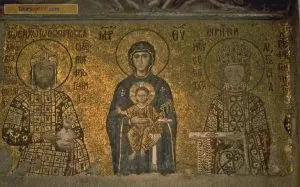
Chora Church
After continuing to serve as a church after the conquest of Istanbul in 1453, it was converted into a mosque in 1511. It was converted into a museum in 1945 and during the restoration carried out by the Byzantine Institute in 1948-1959, mosaics and frescoes were unearthed.
The mosaics and frescoes in Chora are the most beautiful examples from the last period of the Byzantine painting (14th century). The characteristic style elements in these mosaics and frescoes are the elongation of the figures with their depth, movements and plastic values. The Chora church represents Byzantine art at its most experimental. Most of the interior is covered with mosaics depicting the lives of Christ and the Virgin Mary.
Galata Tower
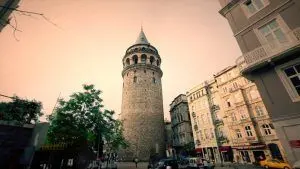
Galata Tower
Galata Tower is one of the oldest and highest towers in Istanbul. It is 63 meters high. You can watch all around Galata tower and Golden Horn.
It was built in the 14th century by the Genoese colony as part of the defensive wall surrounding its regions in Galata. They called the tower “Christea Turris” or “Christ Tower”. Genoese entered the trade with the Byzantines, and the tower was used for the surveillance of the Harbor in Golden Horn. After conquest by Ottoman, it was used as a fire watchtower to detect fires in the city.
Hezarfen Ahmet Celebi the first Turkish to fly in the 17th century Ottoman Empire. The bird copied its wings and examined the air flows of the throat. He flew from the Galata Tower and landed about 6 kilometers (4 miles) from the district of Üsküdar on the Asian continent across the Bosphorus.
On special days and national holidays, light shows are held in the Galata tower. Those who see the tower from the outside watch this visual with interest.
Dolmabahce Palace
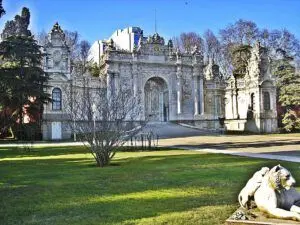
Dolmabahce Palace
Dolmabahce Palace started its construction in 1843, was opened in 1856 after the surrounding walls were completed.
The palace mainly consists of the Imperial State Apartments, the Ceremonial Hall and the Harem. The main building has three floors, basement on the side parallel to the sea, and four floors, on the land side, containing the garret floors and the Harem neighborhoods. Significant Western influences observed in style, details and ornaments are reflections of the changing aesthetic values in the last period of the Empire. It is a building complex where traditional Turkish style is applied in a wide scale in terms of the organization of the space and the relations between the rooms and the halls.
Although the Dolmabahce Palace was under the influence of the West and was built to model European palaces, Harem was built as a separate section, although not as in the past. However, unlike Topkapı Palace, Harem is no longer a separate building or complex of the Palace; however, it is a special living unit located under the same roof within the same building complex. Dolmabahce Palace hosted 6 sultans at intervals and the last Ottoman sultan.
Republic of Turkey founder Mustafa Kemal Ataturk lived here and died here for a while.
Blue Mosque
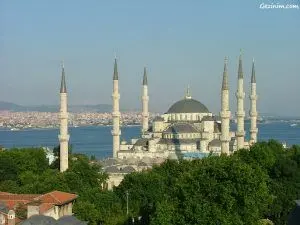
Blue Mosque
Sultan Ahmed Mosque, which is known as the Blue Mosque by many people due to its bluish interior decoration tiles. It is one of the most important mosques in Istanbul standing next to the Byzantine Hippodrome in the old city center. It was built between 1609-1616 by the Ottoman Sultan Ahmed I. Its architect Sedefkar Mehmet Aga was the student of the greatest architect Mimar Sinan.
Like all the major and important mosques of that time, the Sultan Ahmed Mosque was built as a complex like a theology school, an imperial mansion, a kitchen for the poor, arcade shops and a small library to raise money for maintenance. It is the only mosque in Istanbul with 6 minarets. Four of them have three balconies each, and two have two balconies, each with a total of 16 spiral staircases.
There are 3 entrances to the mosque. After entering inside, the flower and geometric interior decoration and beauty of 21 thousand Iznik tiles, about 260 windows with stained glass and calligraphy of the Quranic verses appear. The 34-meter-high central dome is surrounded by smaller domes and semi-domes to disperse the heavy weight of the main dome, and they are all supported by 4 large columns.
Hippodrome
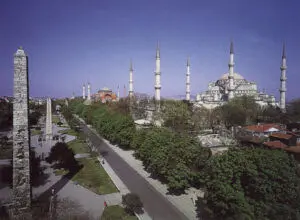
Hippodrome
The Hippodrome, known as the Atmeydanı (horse arena) during the Ottoman era, served as an athletic ground in Byzantine times. It was also used for horse and carriage races, always for the honour of the Emperor. Sultan I. Ahmet (1609-1616) had the mosque built in his name, this historical ground was named after him Sultanahmet. Hippodrome was the center of life in Byzantium and Ottoman. During the Byzantine era, it was an arena where the chariot teams competed.
It was not an arena where gladiators fought like in Rome. It was mostly used for entertaining show. In the Hippodrome square there is Obelisk, serpentine Column, German fountain, Ibrahim pasha palace. It is one of, the top 10 sights in Istanbul.
Grand Bazaar
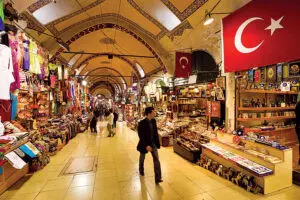
Grand Bazaar
It opens at 09:00 am in the morning and closes at 19:00 pm in the evening. It is the world’s largest indoor bazaar with more than 60 streets, 4,000 shops and 18 doors. Although it is over 550 years old, it still operates very actively. It is crowded always.
When you go inside bazaar, you will feel an authentic oriental atmosphere. All streets are similar eachother but all have different shops.
There are many small shops where you can find all kinds of souvenirs, leather clothing, rugs and carpets, antiques, gold, silver, jewelry, crafts, spices and Turkish delight.
Guests from all over the world travelers come here for shopping. Turkish people going to the Grand Bazaar for gold shopping. There are small streets and small shops outside around the Grand Bazaar. Here trade is made to handicrafts. It is one of, the top 10 sights in Istanbul.
Spice Bazaar
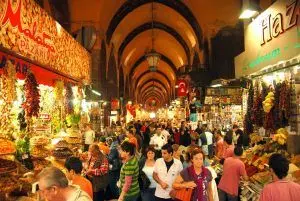
Spice Bazaar
The Spice Bazaar (Egyptian Market) is built between 1597 and 1664, it is also the second oldest covered bazaar in Istanbul. The bazaar is constructed as part of the New Mosque, with rent from the shops supporting the upkeep of the mosque as well as its charitable activities, which included a school, hamam and hospital.
It has been a shopping mall of the Istanbul people with its 400 years old history. This bazaar is one of the most vibrant spots of Istanbul for centuries.
The interior and surroundings of the Spice bazaar has been a region where many people shop. When you enter the Spice bazaar, you feel that old historical smell. Here you can find exotic flavors and a wide variety of spices. It contains a wide variety of shops such as fruits, vegetables, nuts, Turkish delight, gold, silver, flowers, honey, cheese, olives, olive oil and textiles.
The post The top 10 sights in Istanbul appeared first on Turkey Travel Info.

